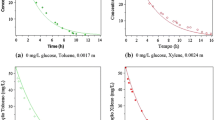Abstract
Experimental data indicate that certain microbiological degradation experiments have a limited reproducibility. Nine identical batch experiments were carried out on 3 different days to examine reproducibility. A pure culture, isolated from soil, grew with toluene as the only carbon and energy source. Toluene was degraded under aerobic conditions at a constant temperature of 28 °C. The experiments were modelled by a Monod model – extended to meet the air/liquid system, and the parameter values were estimated using a statistical nonlinear estimation procedure. Model reduction analysis resulted in a simpler model without the biomass decay term. In order to test for model reduction and reproducibility of parameter estimates, a likelihood ratio test was employed. The limited reproducibility for these experiments implied that all 9 batch experiments could not be described by the same set of parameter values. However, experiments carried out the same day (within the same run) were more uniform than experiments carried out on different days (between runs), and a common set of parameter estimates could be accepted for experiments within runs, but not for experiments from different runs. The limited reproducibility may be caused by variability in the preculture, or more precisely, variations in the physiological state of the bacteria in the precultures just before used as inoculum.
Similar content being viewed by others
References
Alvarez PJJ & Vogel TM (1991) Substrate interactions of benzene, toluene, and para-xylene during microbial degradation by pure cultures and mixed culture aquifer slurries. Appl. Environ. Microbiol. 57(10): 2981- 2985
Arcangeli JP & Arvin E (1994) Kinetics of toluene degradation in a biofilm system under denitrifying conditions. Wat. Sc. Techn. 29, no.10- 11: 393- 400
Atkins PW (1986) Physical chemistry. 3rd edition. Oxford University Press
Bates DM & Watts DG (1988) Nonlinear regression analysis and its applications. John Wiley & Sons, New York
Bilbo CM (1992) Ph.D. thesis. IMM Technical University of Denmark, Lyngby, Denmark
Blok J & Booy M (1984) Biodegradability test results related to quality and quantity of the inoculum. Ecotoxicol. Environ. Safety. 8: 410- 422
Box GEP & Lucas HL (1959) Design of experiments in nonlinear situations. Biometrica. 46: 77- 90
Broholm K, Christensen TH & Jensen BK (1992) Modelling TCE degradation by a mixed culture of methane-oxidizing bacteria. Water Res. 26: 1177- 1185
Chang MK, Voice TC & Criddle CS (1993)Kinetics of competitive inhibition and cometabolism in the biodegradation of benzene, toluene, and p-xylene by two Pseudomonas isolates. Biotechnol. Bioeng. 41: 1057- 1065
Criddle CS (1993) The kinetics of cometabolism. Biotechn. and Bioeng. 41: 1048- 1056
Folsom BR, Chapman PJ & Pritchard PH (1990) Phenol and trichloroethylene degradation by Pseudomonas cepacia G4: Kinetics and interactions between substrates. Appl. Environ. Microbiol. 56(5): 1279- 1285
Gallant AR (1987) Nonlinear statistical models. New York, NY: Wiley and Sons
Gibson LK & Khoury TT (1986) Storage and survival of bacteria by ultra-freeze. Litt. Appl. Microbiol. 3: 127- 129
Grady CPLJr, Smets BF & Barbeau DS (1996) Variability in kinetic parameter estimates: A review of possible causes and a proposed terminology. Wat. Res. 30: 742- 748
Kong Z, Vanrolleghem P, Willems P & Verstraete W (1996) Simultaneous determination of inhibition kinetics of carbon oxidation and nitrification with a respirometer. Wat. Res. 4: 825- 836
Lamarche P & Droste RL (1989) Air-stripping mass transfer correlations for volatile organics. Jour. AWWA Jan p. 78
Lowry OH, Rosebrough NJ, Farr AL & Randall RJ (1951) Protein measurement with the folin phenol reagent. J. Biol. Chem. 193: 265- 275
Machado RJ & Grady Jr. CPL (1989) Environmental systems engineering. Biotechnol. Bioeng. 33: 327- 337
Melgaard H & Madsen H (1991) Identification of physical models. Ph.D. thesis. IMM, Technical University of Denmark, Lyngby, Denmark
Nakhla GF & Al-Harazin IM (1993) Simplified analysis of biodegradation kinetics of phenolic compounds by heterogeneous cultures. Environ. Techn. 14: 751- 760
Pavlostathis SG & Giraldo-Gomez E (1991) Kinetics of anaerobic treatment. Wat. Sci. Tech. Vol. 24(8): 35- 59
Peterson GL (1979) Review of the phenol protein quantization method of Lowry, Rosebrough, Farr and Randall. Anal. Chem. 100: 201- 220
Sáez PB & Rittmann BE (1992) Model-parameter estimation using least squares. Water Res. 26: 789- 796
Simkins S & Alexander M (1984) Models for mineralization kinetics with the variables of substrate concentration and population density. Appl. Environ. Microbiol. 47: 1229- 1306
Sommer HM (1997) Variability in microbiological degradation experiments - analysis and case study. Ph.D. thesis. IMMTechnical University of Denmark, Lyngby, Denmark
Tanner RD, Souki NT & D'Ambrosi OM (1981) Inherent limitations to the problem of reducing the lysine microbiological assay time. Folia Microbiol. 26: 232- 242
Templeton LL & Grady CPL Jr (1988) Effect of culture history on the determination of biodegradation kinetics by batch and fedbatch techniques. J. Wat. Poll. Cont. Fed. 60: 651- 658
Thatipamala R, Rohani S & Hill GA (1992) Effect of high product and substrate inhibitions on the kinetics and biomass and product yields during ethanol batch fermentation. Biotech. Bioengng. 40: 289- 297
Vecht SE, Platt MW, Er-El Z & Goldberg I (1988) The growth of Pseudomonas putida on m-toluic acid and on toluene in batch and in chemostat cultures. Appl. Micro. Biotech. 27: 587- 592
Verschueren K (1996) Handbook of environmental data on organic chemicals. 3rd edition, New York: Van Nostrand Reinhold
Rights and permissions
About this article
Cite this article
Sommer, H.M., Spliid, H., Holst, H. et al. Examination of reproducibility in microbiological degradation experiments. Biodegradation 9, 65–82 (1998). https://doi.org/10.1023/A:1008215914179
Issue Date:
DOI: https://doi.org/10.1023/A:1008215914179




